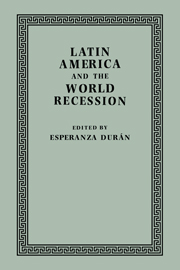Book contents
- Frontmatter
- Contents
- Contributors
- Preface
- 1 The Political Setting: ‘Business as Usual’ or a New Departure?
- Part One The Global Perspective
- 2 Latin America's Financial Crisis: Causes and Cures
- 3 A Comparison of Macroeconomic Strategies in South America
- 4 Latin American and East Asian NICs: Development Strategies Compared
- Part Two Case Studies
- Index
3 - A Comparison of Macroeconomic Strategies in South America
Published online by Cambridge University Press: 05 February 2012
- Frontmatter
- Contents
- Contributors
- Preface
- 1 The Political Setting: ‘Business as Usual’ or a New Departure?
- Part One The Global Perspective
- 2 Latin America's Financial Crisis: Causes and Cures
- 3 A Comparison of Macroeconomic Strategies in South America
- 4 Latin American and East Asian NICs: Development Strategies Compared
- Part Two Case Studies
- Index
Summary
There are few areas of the world in which macroeconomic policy has been as innovative as in South America over the past quarter-century. The rest of the world, the developed and even more the developing, has much to learn from study of this rich variety of experience.
In the 1950s most South American countries pursued expansionary fiscal and monetary policies and import-substituting industrialization, as advocated by the Economic Commission for Latin America (ECLA). The inflationary strains that resulted were validated by passive monetary policies and rationalized as the result of structural imbalances. This strategy was rather successful during the 1950s, but by the early 1960s it was reaching its two natural limits. First, although import-substituting industrialization is initially a sensible policy for developing countries because the first industries established tend to be labour-intensive, further stages of industrialization involve moving on from non-durable consumer goods into consumer durables and capital goods, and these industries require skilled labour, exhibit greater economies of scale, and are more capital-intensive, so that they are less suited to countries at an early stage of industrialization. Secondly, the maintenance of a high level of internal demand led not only to payments deficits but also to accelerating inflation. These problems prompted the periodic adoption of ‘orthodox’ stabilization programmes involving monetary and fiscal restraint and devaluation, in order to restore the balance of payments and a measure of price stability. However, successive stabilization programmes became progressively less effective in restoring price stability as expectations and institutions adjusted to chronic variable inflation.
- Type
- Chapter
- Information
- Latin America and the World Recession , pp. 38 - 47Publisher: Cambridge University PressPrint publication year: 1985



